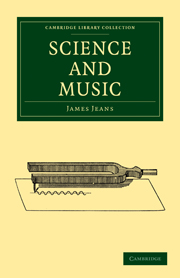Chapter V - Harmony and Discord
Published online by Cambridge University Press: 07 September 2010
Summary
In the present book, we are dealing with subjects which lie partly within the province of science and partly within that of art, and the boundary between the two provinces is not always perfectly clear. If the question is debated as to whether the music of John Sebastian Bach is superior to that of his son Philipp Emanuel, science can bring nothing to the discussion. The question is purely one for artists, and it is quite conceivable, although perhaps rather improbable, that they may not be able to agree as to the answer. On the other hand, if the question is whether the music of either Bach is superior to that produced by a chorus of cats singing on the roof, there will be little doubt as to the answer. The artists will all agree, and science is able to explain to a large extent why they agree.
To say the same thing in another way, the aim of music is to weave the elementary sounds we have been discussing into combinations and sequences which give pleasure to the brain through the ear. As between two pieces of music both of which give pleasure in a high degree, only the artist can decide which gives more, but the scientist can explain why some give no pleasure at all. He cannot explain why we find Bach specially pleasurable, but he can explain why we find the cat music specially painful.
- Type
- Chapter
- Information
- Science and Music , pp. 152 - 190Publisher: Cambridge University PressPrint publication year: 2009First published in: 1937

